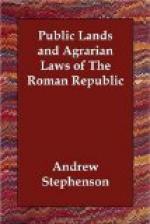This magnanimity was not rare and it even went so far as to restore the whole of the territory to the people subdued.[10] But let us not suppose that this humanity toward a conquered people sprang from any pity inspired by their forlorn condition. It was due merely to the interest of the conquerors themselves. The conquered lands must still be cultivated and the depleted population restored. For this reason the conquered had generally not only life and freedom left them but also the means of livelihood, i.e. some portion of their land. This portion they held subject to no restrictions or services save those levied upon quiritarian property. It was private property to the full legal extent of the expression, thus being in the unlimited disposition of the individual.[11] These people formed the nucleus of the plebeians, the freemen who were members of the Roman state[12] without actually having any political rights.
The Ager Publicus was the property of the state and as such could be alienated only by the state.[13] This alienation could be accomplished in two ways:
(a). By public sale;
(b). By gratuitous distribution.
(a). The public sale was merely an auction to the highest bidder and in the later days of the monarchy and early part of the republic, rich plebeians must have become possessed of large tracts of land in this way; the privilege of acquiring property in land having been extended to them some time before the Servian reform.[14]
(b). The gratuitous distribution of land was accomplished by means of Agrarian Laws or royal grant and had for its object the establishment of colonies for purposes of defence, the rewarding of veterans or meritorious soldiers,[15] or in later times, the providing for impoverished plebeians.
But even in the earliest times a portion of the domain lands was excluded from sale or private appropriation,[16] in order to serve as a resource for the needs of the state.
This was the general usage of ancient republics and this maxim of reserved lands was recommended[17] by Aristotle as the first principle of political economy.
Such reserved ager publicus was leased either in periods of five years (quinquennial leaseholds) or perpetually, i.e. , by emphyteutic lease or copyhold. From these lands[18] the treasury received an income of from one-tenth to one-fifth of the annual crops.
Besides these legal methods mentioned there was another very common one which was seemingly never established by any law and therefore existed merely by title of tolerance. I speak of the indefinite possessio which was nothing but an occupation on the part of the patricians[19] of the land belonging to the state and was in nature quite similar to the so-called “squatting” commonly practiced in some of our western states and territories. The title to the enjoyment of the public lands was at first clearly vested in the patricians




